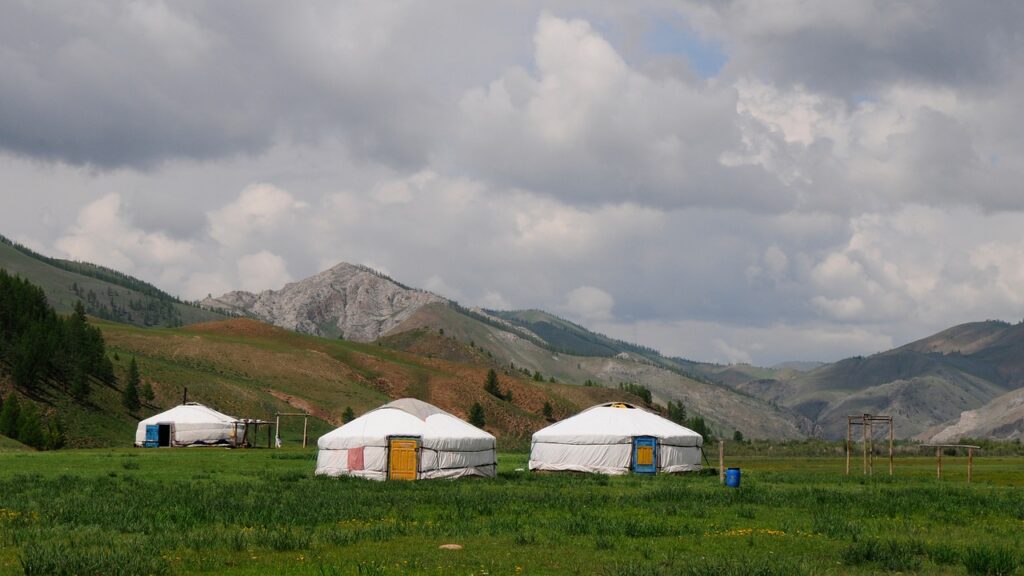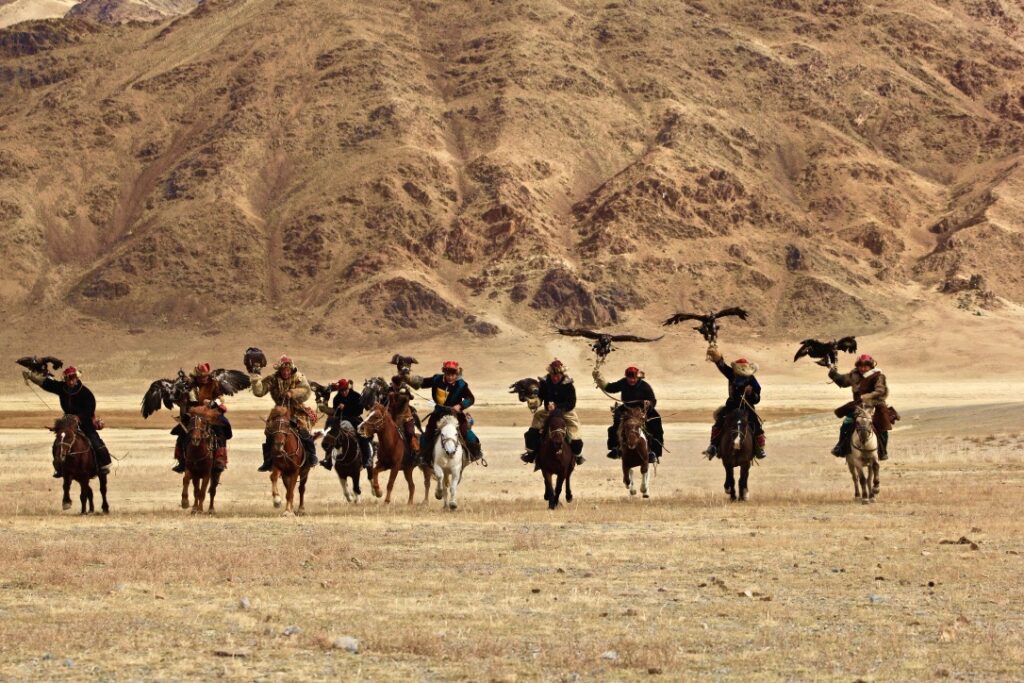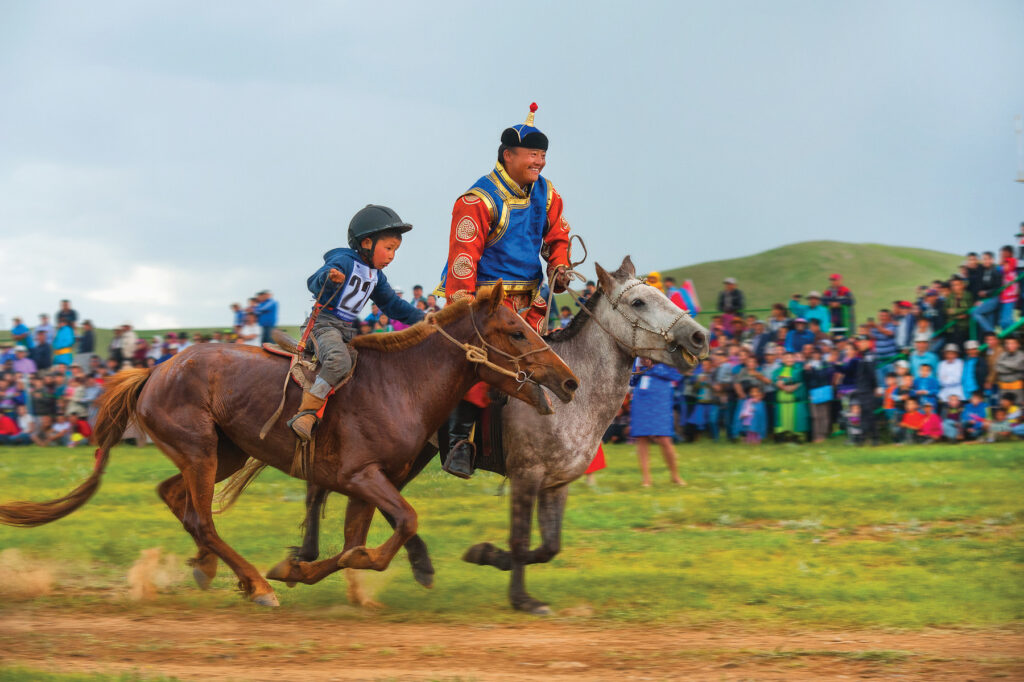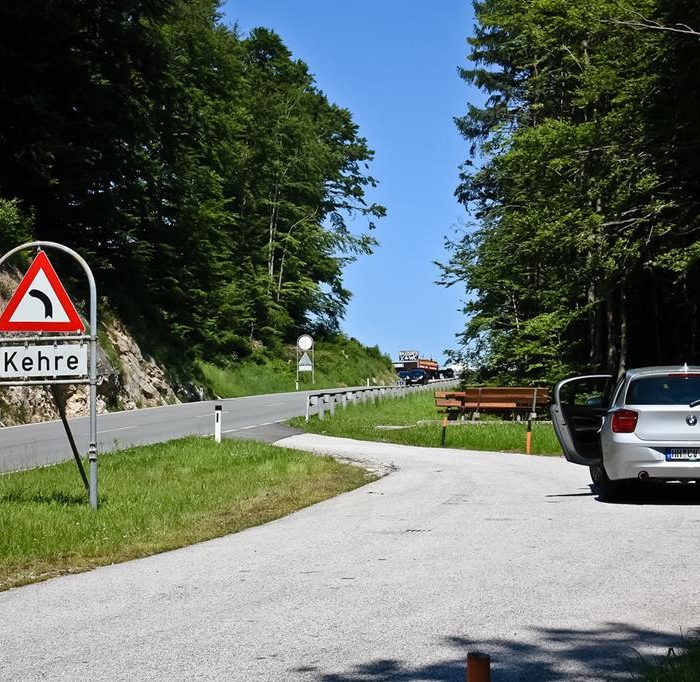10 Interesting Facts About Mongolia
Quick facts about Mongolia:
- Population: Approximately 3.3 million people.
- Capital: Ulaanbaatar.
- Official Language: Mongolian.
- Currency: Mongolian Tögrög.
- Government: Parliamentary republic.
- Major Religion: Buddhism.
- Geography: Landlocked country in East Asia, bordered by Russia and China, characterized by vast steppes and desert regions.
Fact 1: In Mongolia, about a quarter of the people are still nomads
In Mongolia, around one-fourth of the people still live as nomads. These nomadic families roam the vast open plains with their animals, moving to find fresh grass and water for their livestock. This lifestyle has been a part of Mongolian culture for generations, and even as the country modernizes, many still choose to live this way, cherishing their connection to the land and their heritage.

Fact 2: Genghis Khan’s Mongol Empire is the largest empire in human history
Genghis Khan’s Mongol Empire is regarded as the largest empire in human history. At its peak in the early 13th century, it spanned vast territories across Asia, Europe, and the Middle East, covering approximately 22% of the world’s land area and exerting significant influence over countless cultures and civilizations. Genghis Khan’s military prowess, innovative tactics, and strategic leadership enabled the rapid expansion of the empire, leaving an indelible mark on world history.
Their military campaigns resulted in the conquest and subsequent crippling of several large empires and countries, including those in Asia and Europe. The Mongol Empire’s formidable forces, characterized by their swift cavalry and strategic brilliance, posed formidable challenges to even the most powerful nations of the time.
Fact 3: Mongolia’s capital is the coldest capital in the world
Mongolia’s capital, Ulaanbaatar, holds the distinction of being the coldest capital city in the world. Situated in the heart of the country, Ulaanbaatar experiences extreme temperatures, with bitterly cold winters and relatively short, mild summers. The city’s high elevation, coupled with its continental climate and proximity to the Siberian cold air masses, contribute to its frigid winter temperatures, often plunging well below freezing. Temperatures can drop as low as -30°C (-22°F) or even lower during the winter months, making it a unique and challenging environment for its residents.
 Orgio89, CC BY-SA 3.0, via Wikimedia Commons
Orgio89, CC BY-SA 3.0, via Wikimedia CommonsFact 4: Mongolia has clear skies about 260 days a year
Mongolia boasts clear skies for approximately 260 days a year, offering breathtaking views of its rugged landscapes, vast steppes, and majestic mountains. This abundance of clear days allows for exceptional stargazing opportunities and showcases the country’s natural beauty in all its glory. Whether exploring the expansive Gobi Desert or trekking through the remote wilderness, visitors and locals alike can often enjoy uninterrupted views of Mongolia’s stunning scenery under its expansive azure skies.
Fact 5: The Gobi Desert is the largest desert in Asia
The Gobi Desert stands as the largest desert in Asia, renowned for its vast expanses of arid terrain and unique geographical features. Spanning across northern China and southern Mongolia, this sprawling desert encompasses an area of approximately 1.3 million square kilometers (500,000 square miles). Despite its harsh and inhospitable conditions, the Gobi Desert is home to diverse ecosystems, ancient fossils, and nomadic communities, making it a fascinating destination for adventurers, researchers, and nature enthusiasts alike.
 Richard Mortel, (CC BY 2.0)
Richard Mortel, (CC BY 2.0)Fact 6: There are orders of magnitude more horses than people in Mongolia
In Mongolia, the number of horses surpasses the human population by orders of magnitude. With a long history deeply intertwined with nomadic culture, horses play a vital role in the daily lives and traditions of Mongolians. Estimated to be several times more numerous than the country’s human inhabitants, these sturdy and resilient animals are integral to transportation, herding, and cultural practices across the vast Mongolian steppes. Their prevalence underscores the enduring bond between the Mongolian people and their equine companions.
Fact 7: There’s an eagle hunting festival in Mongolia
Mongolia hosts an annual Eagle Hunting Festival, a celebrated event that showcases the ancient tradition of eagle hunting practiced by the Kazakh nomads of western Mongolia. During this captivating festival, skilled hunters, known as “burkitshi,” demonstrate their expertise in training and handling majestic golden eagles. Spectators gather to witness thrilling competitions, including eagle flights, speed trials, and agility tests, all highlighting the remarkable bond between the hunters and their formidable avian companions. Beyond the exhilarating contests, the Eagle Hunting Festival offers a glimpse into the rich cultural heritage and nomadic way of life cherished by the people of Mongolia.
Note: If you plan to visit the country, find out if you need an International Driver’s License in Mongolia to drive.
 Gabideen, CC BY-SA 4.0, via Wikimedia Commons
Gabideen, CC BY-SA 4.0, via Wikimedia CommonsFact 8: It’s customary to eat ice cream in winter
In Mongolia, a unique tradition sees locals indulging in ice cream during the winter months, despite the harsh and freezing temperatures. Embracing the chill of the season, Mongolians savor the cold treat as a beloved winter delicacy, offering a refreshing contrast to the biting cold outside. There is a theory that it was the Mongols who invented ice cream. Riders took cream in containers made of intestines. The cream was whipped during the ride and frozen, making ice cream.
Fact 9: Mongolia has its own Olympic Games
Mongolia hosts its own version of the Olympic Games, known as the Naadam Festival. This festival, deeply rooted in Mongolian culture, features traditional competitions that showcase the skills of nomadic warriors. The three main events of Naadam are wrestling, horse racing, and archery. Wrestling, known as “Bökh,” is particularly revered, with participants engaging in fierce grappling matches that require strength, agility, and strategy. Horse racing is another highlight, with skilled riders guiding their horses across vast distances in thrilling races across the Mongolian steppe. Archery rounds out the festivities, with participants demonstrating their accuracy and precision with bow and arrow.
 Zazaa Mongolia, CC BY-SA 4.0, via Wikimedia Commons
Zazaa Mongolia, CC BY-SA 4.0, via Wikimedia CommonsFact 10: During World War II, Mongolia provided the largest per capita humanitarian aid to the USSR
During World War II, Mongolia provided substantial humanitarian aid to the Soviet Union, making it one of the largest per capita contributors. Despite its relatively small population at the time, Mongolia’s assistance was significant. Exact figures vary, but it’s estimated that Mongolia contributed around 5 million tugriks (Mongolian currency at the time) to the Soviet war effort. Additionally, Mongolia sent medical supplies, clothing, and other essential goods. Moreover, Mongolia donated over 400,000 head of livestock, including horses, camels, sheep, and cattle, to support the Soviet army. This aid was crucial for the Soviet Union, especially during the harsh winters on the Eastern Front. Mongolia’s remarkable contribution exemplifies its unwavering support for its ally during a critical period in world history.





